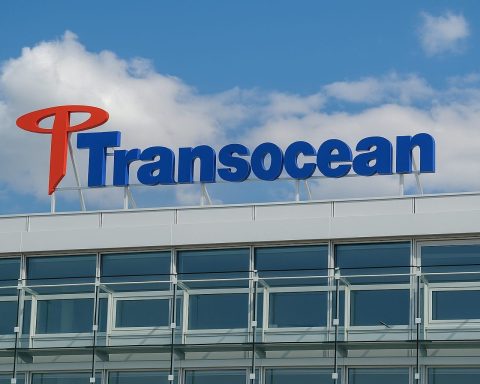Transocean Ltd. (NYSE: RIG) is grinding higher again on Tuesday, November 25, 2025, as investors continue to digest a run of positive contract news, a solid third-quarter earnings beat, and fresh interest from institutional buyers—all against a volatile oil market backdrop.
Key Takeaways
- RIG stock is trading around $4.05 today, up roughly 0.7% from Monday’s close near $4.02, with more than 37 million shares changing hands and an intraday range between about $3.90 and $4.10. [1]
- Shares have climbed roughly 25–27% over the past month but remain modestly lower versus a year ago, underscoring how sharp the recent rebound has been after a tough 2025. [2]
- Transocean recently added about $89 million in new contract backlog through exercised options on one ultra‑deepwater drillship and two harsh‑environment semisubmersibles, building on a third‑quarter backlog of $6.7 billion. [3]
- Q3 2025 results showed improving operations but big accounting noise: adjusted net income was $62 million ($0.06 per share), even as a $1.9 billion impairment charge pushed the reported bottom line deep into the red. [4]
- Institutional activity is mixed but active: one fund just initiated a 6 million–share position, while other large holders have either boosted or trimmed exposure. [5]
RIG Stock Price Today, November 25, 2025
By late Tuesday’s session, Transocean shares were trading around $4.05, up about 0.03 dollars (roughly 0.7%) on the day. The stock opened near $4.03, has traded between approximately $3.905 and $4.09, and volume is running above 37.5 million shares. [6]
That move adds to Monday’s strong “green day,” when RIG climbed 3.34%, closing at $4.02 after swinging between $3.88 and $4.07 on roughly 34 million shares. Over the last 10 sessions, the price has moved higher in half of the trading days but is still down a little more than 4% over that short window, a reflection of just how choppy trading has been. [7]
From a longer‑term perspective:
- 52‑week range: about $1.97 to $4.52—today’s price is a bit more than 10% below the 52‑week high and roughly double the 52‑week low. [8]
- Market value: roughly $4.4 billion in market capitalization at current prices. [9]
- Fundamentals (last 12 months): about $3.9 billion in revenue and a net loss near $2.9 billion, largely reflecting impairments and heavy interest costs; trailing EPS is about –$3.37. [10]
Multiple data providers also highlight that, depending on the exact start date, RIG is still down mid‑single to low‑teens percent over the past year, even after its recent rally—a reminder that this is a bounce from a low base, not a smooth uptrend. [11]
Why RIG Is Moving: Contracts, Backlog and Earnings
$89 Million in Fresh Backlog
The most recent hard news for Transocean came on November 18, 2025, when the company announced that customers had exercised options totaling roughly $89 million in firm contract backlog. The deals cover:
- One ultra‑deepwater drillship, with a 90‑day option exercised by Petrobras in Brazil.
- Two harsh‑environment semisubmersible rigs, tied to new work in Norway and Romania. [12]
This $89 million is incremental to the company’s already substantial $6.7 billion backlog reported alongside its third‑quarter results in late October. [13]
The November options also follow an earlier $243 million block of exercised options announced on October 1 for two other ultra‑deepwater drillships, signaling that major customers continue to lock in capacity over multi‑year horizons. [14]
For investors, backlog matters because it:
- Provides visibility into future revenue, often years out.
- Can give clues about day‑rates and demand for premium rigs.
- Acts as a buffer when the spot market for drilling contracts softens.
Q3 2025: Operational Strength vs. Accounting Hit
Transocean’s third‑quarter 2025 results are another key piece of the puzzle. On October 29 the company reported: [15]
- Contract drilling revenue: about $1.03 billion, up from $988 million in Q2 and $948 million a year earlier, driven by better utilization, high revenue efficiency (~97.5%), and higher day‑rates on certain rigs.
- Adjusted EBITDA: around $397 million, up from $344 million in the prior quarter, with an adjusted EBITDA margin of 38.7%.
- Adjusted net income: roughly $62 million, or $0.06 in adjusted diluted EPS.
- Backlog:$6.7 billion as of the October fleet status report.
The catch is a massive non‑cash impairment charge:
- Reported net loss was about $1.92 billion, or –$2.00 per share, largely due to $1.908 billion in asset impairments and a $75 million loss on conversion of debt to equity. [16]
Zacks and other analysts framed the quarter as operationally strong—with earnings and revenue beating consensus—despite the headline loss, thanks to firmer day‑rates and better fleet utilization. [17]
Big Money Moves: New Fund Buyer vs. Profit‑Taking
One of today’s headline drivers is a new article highlighting a “bold new position” in Transocean by Ninepoint, a fund that just disclosed a sizable stake in its latest 13F filing. According to data aggregated by StockInvest, the fund: [18]
- Acquired about 6,000,000 RIG shares,
- Increased its portfolio value by an estimated $18.7 million, and
- Now holds a stake representing roughly 2.5% of its reportable 13F assets.
That kind of fresh institutional buying is often read as a vote of confidence that the recent rally could have more room to run, especially when it follows an extended period of underperformance versus the broader market. [19]
At the same time, other institutional holders are repositioning:
- Creative Planning boosted its RIG holdings by about 89.6% in the second quarter, to roughly 1.07 million shares.
- Bank of New York Mellon Corp cut its position by around 35.6%, according to recent 13F data. [20]
The takeaway: flow data is mixed but active—some large investors are leaning into Transocean’s offshore story, while others are using the rebound to trim exposure or rebalance after the September share offering and ongoing volatility.
Sector Backdrop: Shale Pain, Offshore Potential
RIG’s story can’t be separated from the broader oil market. A recent Reuters piece on the Permian Basin highlights how $60‑ish crude oil is pressuring U.S. shale producers: rig counts are falling, layoffs are rising, and equipment is being liquidated as inflation and saturated sweet spots squeeze economics. The article even suggests that, at current prices, future supply growth may lean more on offshore projects than shale, where breakevens have crept higher. [21]
For Transocean, that macro backdrop cuts both ways:
- Positive:
- Offshore projects—especially deepwater and harsh‑environment developments—can look attractive when shale growth stalls and majors seek long‑life reserves.
- A tighter market for high‑spec rigs supports higher day‑rates and better utilization, which is already showing up in Transocean’s numbers. [22]
- Risk:
- If oil prices fall further or stay depressed for long, even offshore projects get delayed or canceled.
- Financing large deepwater projects is capital‑intensive, and a risk‑averse industry can pull back quickly.
Valuation, Analyst Views and Trading Picture
On today’s numbers, RIG screens as a high‑beta, high‑risk offshore play rather than a tidy value stock:
- No dividend at present.
- Trailing net loss of roughly $2.9 billion over the last twelve months. [23]
- Balance sheet still debt‑heavy, despite ongoing tender offers and refinancing moves, such as the new 2032 notes and recent cash tender offer announced in late September. [24]
From a Wall Street perspective:
- Consensus rating: roughly “Hold” from nine analysts.
- Average 12‑month price target: about $4.41, implying single‑digit upside (~9%) from current levels. [25]
Technical and sentiment‑oriented services add more color. StockInvest’s latest commentary, updated after Monday’s close, notes that: [26]
- The stock is in a short‑term rising trend, with their models expecting further upside over the next three months, albeit with wide confidence bands.
- Support levels cluster around $3.90, with resistance near $4.13–$4.20 based on accumulated volume and Fibonacci levels.
- Daily volatility around 5–6% is typical, which they characterize as medium risk—but enough to warrant close attention to position sizing and stop‑loss levels for active traders.
Combine those technicals with earlier commentary from outlets like Forbes, which has framed RIG as “low valuation but high risk” and significantly lagging the S&P 500, and the picture is clear: the market is still debating whether Transocean’s improved fundamentals justify a sustained rerating. [27]
What to Watch Next for RIG Stock
For traders and longer‑term investors following RIG, the key questions over the next few months include:
- Backlog and day‑rates
- Do future fleet status reports show continued backlog growth and higher day‑rates for premium rigs?
- Are customers still willing to exercise options and sign multi‑year contracts at attractive economics? [28]
- Oil price and offshore spending
- Does the current shale slowdown really translate into a capex shift toward offshore, or do energy companies simply tighten budgets overall if oil remains stuck near $60? [29]
- Debt management and dilution risk
- How aggressively does Transocean continue to refinance or retire debt?
- Will further equity offerings be needed if the offshore upcycle stalls, following the large share sale announced in late September? [30]
- Earnings quality
- Are we seeing repeatable cash flow and adjusted earnings, or one‑off boosts tied to specific rigs and contracts?
- Future quarters with fewer impairments will make it easier to judge the underlying profitability trend. [31]
Bottom Line
On November 25, 2025, RIG stock is quietly extending its recent rebound, trading a little above $4 on the back of new contracts, a hefty backlog, and improving operational metrics, while still carrying the scars of heavy impairments, leverage, and prior dilution.
For now, the market’s verdict is cautious: analysts, on average, call it a Hold, and institutions appear split between building positions and taking profits. Whether Transocean’s offshore franchise ultimately justifies a higher sustained valuation will likely depend on two things: how long the offshore upcycle lasts—and how disciplined the company remains with its balance sheet.
This article is for informational purposes only and does not constitute financial or investment advice. Always do your own research and consider consulting a licensed financial professional before making investment decisions.
References
1. stockanalysis.com, 2. simplywall.st, 3. www.deepwater.com, 4. www.deepwater.com, 5. stockinvest.us, 6. stockanalysis.com, 7. stockinvest.us, 8. stockanalysis.com, 9. stockanalysis.com, 10. stockanalysis.com, 11. www.fool.com, 12. www.deepwater.com, 13. www.deepwater.com, 14. stockanalysis.com, 15. www.deepwater.com, 16. www.deepwater.com, 17. stockinvest.us, 18. stockinvest.us, 19. www.fool.com, 20. stockinvest.us, 21. www.reuters.com, 22. www.deepwater.com, 23. stockanalysis.com, 24. www.globenewswire.com, 25. stockanalysis.com, 26. stockinvest.us, 27. www.marketbeat.com, 28. www.globenewswire.com, 29. www.reuters.com, 30. stockanalysis.com, 31. www.deepwater.com










